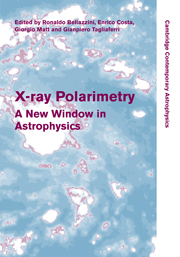Book contents
- Frontmatter
- Contents
- List of contributors
- Preface
- 1 X-ray polarimetry: historical remarks and other considerations
- Part I Polarimetry techniques
- 2 Scattering polarimetry in high-energy astronomy
- 3 Photoelectric polarimeters
- 4 Bragg crystal polarimeters
- 5 X-ray polarimetry with the photon-counting pixel detector Timepix
- 6 High-energy polarized photon interactions with matter: simulations with Geant4
- 7 The GPD as a polarimeter: theory and facts
- 8 Ideal gas electron multipliers (GEMs) for X-ray polarimeters
- 9 Broad-band soft X-ray polarimetry
- 10 Feasibility of X-ray photoelectric polarimeters with large field of view
- 11 Angular resolution of a photoelectric polarimeter
- 12 Development of a Thomson X-ray polarimeter
- 13 Hard X-ray / soft gamma-ray polarimetry using a Laue lens
- Part II Polarized emission in X-ray sources
- Part III Future missions
- Author index
- Subject index
7 - The GPD as a polarimeter: theory and facts
from Part I - Polarimetry techniques
Published online by Cambridge University Press: 06 July 2010
- Frontmatter
- Contents
- List of contributors
- Preface
- 1 X-ray polarimetry: historical remarks and other considerations
- Part I Polarimetry techniques
- 2 Scattering polarimetry in high-energy astronomy
- 3 Photoelectric polarimeters
- 4 Bragg crystal polarimeters
- 5 X-ray polarimetry with the photon-counting pixel detector Timepix
- 6 High-energy polarized photon interactions with matter: simulations with Geant4
- 7 The GPD as a polarimeter: theory and facts
- 8 Ideal gas electron multipliers (GEMs) for X-ray polarimeters
- 9 Broad-band soft X-ray polarimetry
- 10 Feasibility of X-ray photoelectric polarimeters with large field of view
- 11 Angular resolution of a photoelectric polarimeter
- 12 Development of a Thomson X-ray polarimeter
- 13 Hard X-ray / soft gamma-ray polarimetry using a Laue lens
- Part II Polarized emission in X-ray sources
- Part III Future missions
- Author index
- Subject index
Summary
The advent of a new generation of X-ray polarimeters based on the photoelectric effect poses the problem of their calibration. We devised and built a calibration facility aimed at the study of the performances of photoelectric X-ray polarimeters such as the Gas Pixel Detector (GPD). The calibration facility exploits the 45° Bragg diffraction from crystals of both X-ray lines characteristic of X-ray tubes and from continuum. A set of linear and rotary stages allows the GPD to be calibrated on its whole surface. We successfully tested the GPD filled with a mixture of He-DME 30-70 at one atmosphere. We measured the modulation factor at 2.69 keV and 4.51 keV. We also studied the homogeneity of the modulation factor, of the angular phase and of the position reconstruction capability on the surface of the GPD.
Introduction
Since early 2000 we have been developing true 2-D X-ray polarimeters based on the photoelectric effect. The Gas Pixel Detector (GPD), an evolution based on the use of an ASICCMOS readout chip, has been calibrated at energies greater then 5 keV with a Thomson based X-ray polarizer. However, the sensitivity of the GPD at the focus of conventional X-ray optics peaks below 5 keV. In this regime the photoelectric effect severely competes with Thomson scattering. For this reason we developed a facility aimed at the production of polarized X-rays in the few keV band.
- Type
- Chapter
- Information
- X-ray PolarimetryA New Window in Astrophysics, pp. 54 - 59Publisher: Cambridge University PressPrint publication year: 2010
- 1
- Cited by

